



Featured image: Screen capture of Joseph DeLappe’s intervention in America’s Army
The Fresno Art Museum, in collaboration with the Fresno State Center for Creativity and the Arts, is exhibiting “Social Tactics,” a mini-retrospective of the work of Joseph DeLappe, a new media artist and director of the Digital Media Program at the University of Nevada, Reno. The exhibit has been running alongside the construction of a to-scale sculptural reproduction of an MQ1 Predator Drone on the campus of Fresno State, coordinated by DeLappe and executed by students and volunteers. I had the opportunity to interview DeLappe about his work, and the way it connects to militarism, memorialization, and embodiment. His work has been an ongoing critique of games that look like war, and warfare that looks like gaming – insisting that, within the hall of mirrors that forms “simulation culture,” reality still must be accounted for, and attended to.
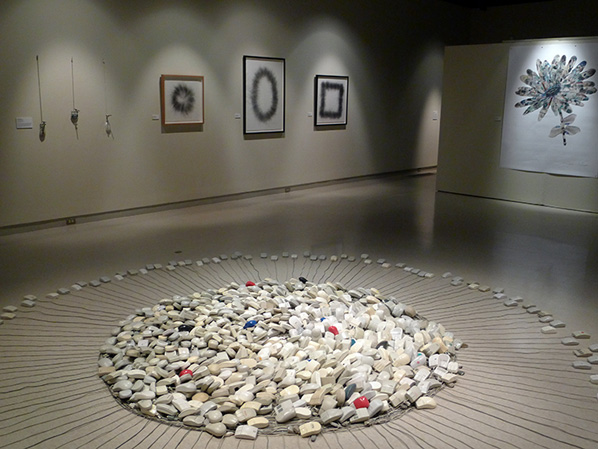
The earliest work in the show is a series of riffs on the computer mouse. The “Mouse Mandala” (2006) splits the difference between a trash heap and an object of meditation – a small sargasso of computer mice is ringed by a circle of yet more mice. The outer radius, tethered to the central mass by extended mouse cords, makes the whole sculpture resemble a dingy grey sun – one that has been pawed by innumerable, invisible fingers. His “Artist’s Mice,” first begun in 1998, are a series of mice that have drawing implements attached to them, so that the mice can draw while being utilized for their normal activities. The drawing attachments resemble braces, as though the mice are being rehabilitated from an injury – the drawings produced by them are beautiful abstractions, circular or square scribblings that give the illusion that, while working or gaming or goofing off, we could also be making art – skimmed off the surface of our interface with our machines.
All these mice, removed from the context of their guiding hands, inevitably – if ambiguously – echo with a pair of outsized sculptural hands, titled “Taliban Hands” (2011). Modeled from white plastic polygons, the left hand in particular looks as if it could be cradling an invisible, equally outsized mouse. The right hand has its pointer finger extended, as if it were about to press a button. The fact that the hands are upturned short-circuits those prosaic possibilities of gesture, turning them into gestures of supplication. The hands were constructed from 3D data extracted from the model of a Taliban fighter in the game “Medal of Honor,” and once you learn that, it’s easy to imagine the right hand gripping a gun, the extended finger wrapped around the trigger. The disembodied nature of the hands is discomfortable – it feels like a dismemberment, a pair of hacked war trophies offered up for display.
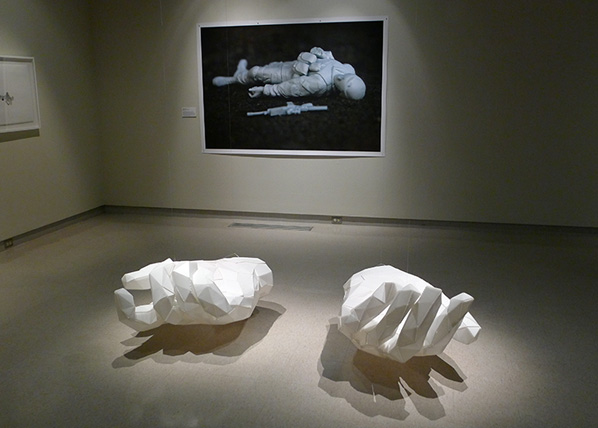
DeLappe also used polygon modeling for a small replica of a US military Drone that hangs in the gallery, which served as a prototype for the life-size drone constructed as a memorial on the grounds of Fresno State. Where the “Taliban Hands” and drone prototype are white and pristine, the Drone Memorial was designed to be inscribed upon. In a public ceremony, volunteers wrote the names of 334 civilian casualties of drones on the faceted surface of the sculpture.

DeLappe’s years-long project “dead-in-iraq” (2006-2011) is represented by a machinima video and a large-scale digital print modeled after his fallen avatar in the US Army recruitment game America’s Army. Over the course of the American war with Iraq, DeLappe entered the multiplayer first person shooter game, and at the start of each mission threw down his weapon and began typing in the names of US military personnel who had been killed in Iraq. His avatar was invariably shot, either by the opposing team or by members of his own team. In the latter case, it’s as though his killers are trying to gun down an itch of conscience – or the nuisance of reality itself. In the machinima of this intervention, when Delappe positions his camera above his virtual corpse, there is sometimes a very profound effect of quietude. The body occasionally twitches, in a gruesome effluvium of game physics, or puffs of smoke are kicked up by stray bullets – but those filigrees of activity only heighten the feeling that the game has moved on. It brings to mind bodies left on real battlefields, unattended to, abandoned to the weather and the birds and the insects while the important business of fighting continues.

“Project 929: Mapping the Solar” (2013) echoes the circularity of the Mouse Mandala. For the project, DeLappe rode a bicycle 460 miles in a circuit around Nellis Air Force Base in Southern Nevada. The bicycle was outfitted with an apparatus that held a series of pieces of chalk to the road – DeLappe was both marking a chalk outline around the base, and mapping out the dimensions of a solar farm that could power the entire United States, based on a size estimate from the Union of Concerned Scientists. The project is shown through a series of photographs, a video, and the modified bike itself, with a circle of chalk stubs positioned under the frame. In some ways, the piece expands the logic of the “Artist’s Mice” to a different scale. Instead of the hand being the driving force, the whole body is the recorded object, and rather than being confined to the top of a desk, the drawing itself is allowed to range across hundreds of miles. In this case, the drawing is the opposite of accidental – it’s utopian.

Not represented in the show – but a point of discussion in our interview – was the “Salt Satyagraha Online” (2008), a 26-day durational performance which used a customized treadmill to control the movement of a Second Life avatar modeled after Mahatma Gandhi. On the treadmill, installed at Eyebeam Art and Technology in New York, DeLappe walked the 240 miles Gandhi marched in protest of a British Salt tax – driving his avatar, step by step, across the territory of Second Life. That project was yet another of DeLappe’s exploratory reconfigurations of the relationship between protest, performance, and physicality.
Chris Lanier: With the mouse-derived work, from the “Mouse Mandala” to “The Artist’s Mouse” and the drawings that are made as you’re playing a game – what was it like putting those things together at this time, when it’s possible to imagine the disappearance of the mouse? Right now there is eye-controlled software , and even thought-controlled software…
Joseph DeLappe: Part of my thought process when doing the mouse pieces was doing a sort of reverse engineering, and trying to figure out what that thing is, because it really is a useless little object otherwise. It’s not a hammer, it’s not a screwdriver, it doesn’t have a function beyond plugging into a computer to allow you to move around this detached marker on a screen. There’s already something separate happening, and so attaching a pencil to it was a way of perhaps returning it to its roots. It’s sort of a drawing device, a pointer, all these things that a pencil might be, but I was intrigued by the possibilities of extracting some kind of meaning out of it.
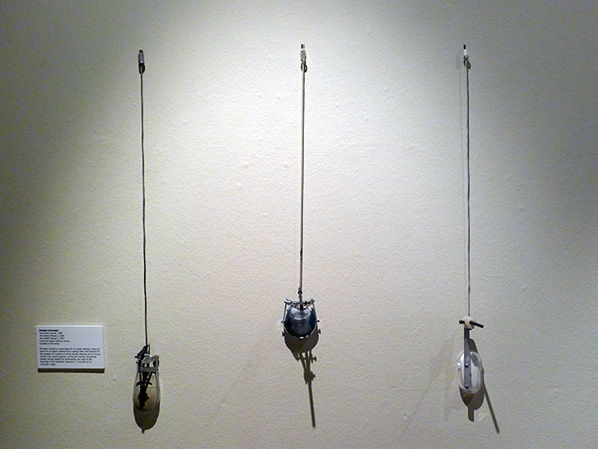
CL: It’s funny because it’s an extension from the computer to the human, like an organ that extends itself to us, and I wonder what you think of that interface becoming even more disembodied. If the hand is taken out of that circuit, what do you think that says about our relationship to the screen?
JD: I think it will change it. I can really only speak from my experience, not having played the wii, or things like that. I messed around with the kinect a little bit. When you’re putting the body into works like what I did in the Gandhi project (which is something that’s not in the exhibition) – I placed myself on a treadmill to actually interact with Gandhi, walking him through Second Life. My body became the game controller in a kind of way, the mouse – or however you want to refer to it. I didn’t realize it at first but there was an intrinsic alteration of my relationship to the experience going on, on the screen. I wonder if that deterioration of that awkward physical thing you have to do with the mouse or track ball, if that’s going to bring us closer to our machines. As it becomes gestural and everyday, I suspect it will become more naturalistic.
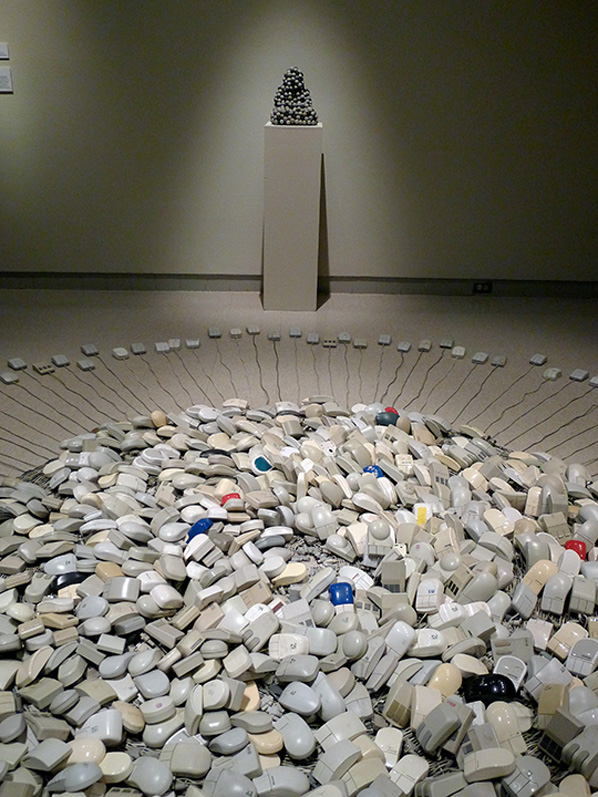
CL: Listening to you talk about the Gandhi project, it seemed to bring you more directly and somatically into that virtual world.
JD: Which was very unexpected. I went into that project from a conceptual durational performance ideation – this would be an examination of “performance,” in quotes. Performance and protest. It was done at Eyebeam in New York, and I was thinking about the many durational performances that had taken place in New York, from Tehching Hsieh, to Linda Montano, to Joseph Beuys. I had done performance works online for almost a decade prior to that piece, but that action that the body involves, that was just transformative. It was amazing and intriguing and kind of disconcerting in a way, because I found myself completely drawn into that experience, and connected to my avatar in a way that I never had previously. I was walking in Second Life, which you’re really not supposed to do – you’re supposed to teleport – so I was navigating over mountains and in places people don’t generally walk. And Gandhi would fall off a mountain-side into the next region, and I’d find myself almost falling off the treadmill. Or, after finishing the performance for the day, walking to the subway and thinking I could click on someone to get information. It became this mixed reality in my head.

CL: Embodiment seems to be a crucial part of your practice. With “Taliban Hands,” you extracted hands from Medal of Honor, and brought them into physical space. In the “dead-in-iraq” project you brought the names of the dead soldiers into the game space of America’s Army. It seems that bringing bodies into that space, or extracting bodies out of that virtual world, is important to you.
JD: Well, each of those pieces had different but connected intents. With the America’s Army project, “dead-in-iraq,” the intent was to embody the reality of the war, to bring it to this virtual space. So when you’re dying and or you’re killing in that virtual space, and you see these names go across the screen, you realize that this is an actual person that died in that conflict. That might change another player’s thought process about what they’re doing, and about that visualization – when you get shot you end up hovering over your fallen avatar. So there is this attempt to change how one considers that experience.

CL: It’s interesting, with the self-portrait as dead soldier – the way of marking yourself as dead is to show the body within the game. Moving you from a first-person space, a first-person-shooter space, into a third-person space. The body becomes a marker of death.
JD: That is certainly a problematic aspect of that game. I think the vast majority of the people playing the game – certainly there are some veterans and active military – but there are more people who aren’t in that situation. So there is this kind of temporary inhabiting of the US military. Bringing this out into real space is an attempt to drive home the connection of that fantasy pretend space to a very real space. It’s like bringing it to a sort of mid-ground. The America’s Army game is in fact official US military virtual space. I mean they own it. It is federal space – it’s part of the system of hundreds of bases around the world.

With the Taliban hands, it’s a similar attempt, but with a different thought process. With the America’s Army game, one of the most devilish things they did with that game is that they’ve created a system where everybody gets to be a good guy. There are two teams, and you see your team of 2 to 12 cohorts playing against 2 to 12 other cohorts. You always see yourself as Americans. They always see themselves as Americans, but you see each other as terrorist enemies. So there’s this digital switching, where they see your avatar as a Middle Eastern terrorist and vice versa.
CL: The strange thing that happens is that you’re inhabiting two bodies.
JD: Yeah, at the same time, exactly. But in the Medal of Honor game it’s not like that. That was a controversial game when it came out in 2010 because you could play as a Taliban killing American soldiers. It was the only game that was actually banned from military bases. They ended up changing it before they released it – they weren’t called “Taliban,” they were called OP 4, which stands for opposition forces. But you’re still Taliban. So anytime that game is being played as an online match, 50% of the players are being American and 50% are being Taliban.
I found that really curious. I started extracting these maps from that particular game, and then diving into this incredible morass of 3-D data. I would have to dig through all of this wireframe stuff to find these objects, and I found the Taliban and started deleting everything else, and landed at one point with the hands. It was just so intriguing – these hands were gorgeous. When they became disembodied from their source and I started visualizing them in the 3-D software, they took on a kind of Da Vinci-esque quality – like the hand of God or something.
CL: There is a gestural quality to it.
JD: Yeah, exactly.
CL: I’m curious if this work has brought you more into contact with the idea of simulation. Simulation can be useful, obviously – it allows you to think through a situation before it’s actually encountered. But then it can actually introduce errors into the actual [situation], because the simulation doesn’t correspond absolutely to reality.
JD: I don’t know if this connects to your question at all, but if you die in America’s Army – this is standard in most shooter games – they have something called the ragdoll effect. It’s a simulation of your body going limp. It’s meant to give a naturalistic [simulation of] you collapsing, and you’re dead. But the effect is actually quite different – there are points where your avatar, in that space – it can be almost comical, like you’re going to do a somersault. And every time you actually die, your body – because of that ragdoll effect – you watch the video and the avatars do this kind of shaking thing, that’s part of this ragdoll effect. When I first saw it I thought it was this macabre death spasm, but it’s just part of the simulation. It’s not meaningful in the context of the game, but it becomes meaningful in the work that I did and in the recording of it.
CL: It’s funny that a simulation can have these unintentional, almost poetic, effects – if you are attuned to it.
JD: And that’s a good metaphor for the whole project, right? It’s taking this simulated wargame – this recruiting tool – and re-branding it, remaking it. It’s a way to say: “No, let’s see if we can make this game be about this, not about that.” I appropriated the space – I took it over in a simple way, and I think it was quite effective.
CL: You frame yourself as an activist as well as an artist.
JD: Yeah, and sometimes uncomfortably. I drift in and out of that. There’s a difference between being an artist and activist. And right now I’m feeling rather reticent [about the “activist” label] – but I’m an artist at base. It’s a little bit more symbolic I guess…
CL: Making a political act in a virtual space – is that inherently symbolic?
JD: That’s a really interesting question because in the progression of my work, I think my work has slowly emerged towards existing in a real space – with the bike-riding around the Air Force base, and now building a life-sized predator drone down in Fresno.

As an artist you do deal with a kind of symbolic reality – metaphor and symbolism, and things that communicate ideas through form. As an activist it seems there would always be a goal of actually fostering change, making change happen in the world. Whether activism is effective at doing that – that’s a really big question too, right? I’m not sure sure if that’s the case these days. That’s one of the reasons I was interested in going into the America’s Army project. It was seeing the – I wouldn’t say the complete failure – but the invisibility of traditional forms of protest. You had the world’s largest worldwide gatherings of protest, a year before we started that war, which was totally under-reported…
CL: And under-counted.
JD: Right. And I’m not saying that I never want you to go protest in these places, but you do have to push that envelope into places where people would not expect it, to actually reach people. And that was a surprise actually, that that piece resonated so powerfully with others – and became a viral thing that, by accident, was disseminated to a huge audience. That was good. But I’m not sure how I feel about it as a kind of permanent venue for trying to do that kind of thing.
With the “dead-in-iraq” project, there were some people who were criticizing it, saying, “Well, you’re just sitting there at your keyboard.” It’s like: “Yeah? Right. I know that – that’s part of the point. Everybody playing that game is sitting at their keyboard.”
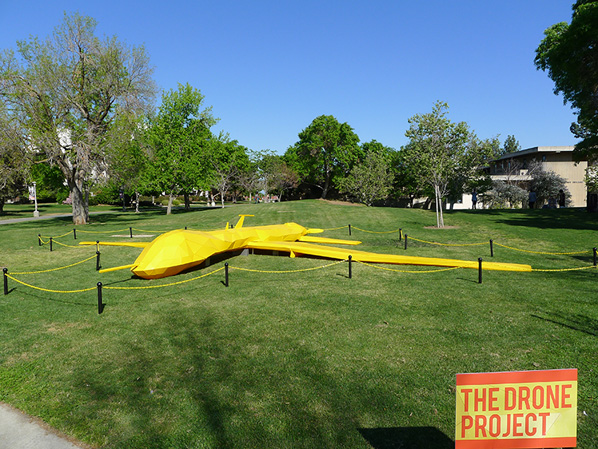
CL: And the people who are manning drones are sitting at their keyboards.
JD: Precisely, and that’s exactly one of the reasons I’m so interested in drones. Speaking of embodiment, the drones –it’s like a perfect synthesis of computer gaming culture, and our militarism, and our love for the latest possibilities of technology. It’s like somebody bashed those things together and out came this perfect system for blowing shit up on the other side of the planet – sitting in your comfortable gamer’s chair.
CL: The way you’re activating the Drone Memorial as an extension of your art activism – I’m wondering if part of the appeal is doing it within an educational institution, where you’re enlisting students to help you out, so it actually becomes part of an educative process. How much do they know about the drone policy?

JD: What’s interesting with that project is that they brought up these different groups – art students, design students, and there has been a group of activists from Fresno called Peace Fresno who’ve come out to work. There have been some TV interviews, and there’s a journalism class – they’re taking turns, every day there’s a different crew and they’re documenting the process and interviewing the people that are involved. And it’s been interesting talking to some students because there have been a number of students that are like: “What, drones? We can blow stuff up in Pakistan, from sitting in Las Vegas at Creech Air Force Base?” They don’t know about it, so there is a kind of basic informational aspect of the project.
But what I’m finding most interesting is that the students and volunteers – and myself – at this stage of the work we’re so absorbed in the embodiment, if you will, of the physical sculpture. It’s a building process and there’s a kind of pleasure in that. There’s the hands-on aspect of building, and seeing this form come into being. What I’m waiting for is that realization when we get the whole thing together, and it has this 48 foot wing span and 27 foot fuselage, sitting on the ground at the campus – and then we write the names [of the civilian casualties on the sculpture] – we have 334 names in English and Urdu.

I think that’s going to have a powerful impact, that’s going to completely flip the equation. Not just to give them a sense of their making something as a community build – but that we own these drones – we are this policy. These victims that are on the drone are connected to us, right? There’s a direct lineage from that pilot sitting in Creech Air Force Base, from the missile that rained down on that village and killed a 12-year-old girl, to you and me. It may be tentative, but it’s our government – it’s us.
Conclusion.
The interview was conducted several days before the completion of the Drone Memorial. After the sculpture was assembled and installed, there was a public ceremony at the site. Afterward, I asked Joseph if the effect of the ceremony was in fact what he envisioned, and he sent me the following reply via email:
We finished the drone just as the ceremony was scheduled to commence. There was a crowd of about 75 people – I made some brief comments thanking the volunteers and the CCA. The actual ceremony was being coordinated by a wonderful group, “Peace Fresno”, who coordinated the creation of individual, hand written index cards, each with the name, date of death and age (if available), of each of the 334 Pakistani drone victims. These were read aloud by individuals from Peace Fresno of Pakistani or Indian descent to ensure that the names were correctly pronounced. Those gathered for the event stood in line to take possession of a name after it was read aloud – walking towards the drone where they were given a pen. Each name was written with the associate dated of death and age of the victim when available. Several volunteers followed this process by filling in the names translated into Urdu.

I personally completed the process of standing in line, taking a pen and writing names on the drone 7-10 times, I lost count. The most memorable was that of an 8 year old girl – I don’t recall her name but after writing on the drone the realization of the death of a child was quite overwhelming. Others had similar experiences – there were several walking away from the drone after writing their name who were in tears. This cycle of writing, standing in line and continuing the process went on for perhaps 45 minutes until all 334 names were written upon the drone. All the while there were passersby stopping, asking what we were doing, some joined us. I recall a father on a bicycle have a discussion with his young son about drones, “are you ok with being surveilled 24/7?”, that kind of thing.
In my exhaustion after working 2 weeks followed by an additional weekend of 11 hour work days, the experience was moving and quite overwhelming. There was indeed a palpable realization of the nature of the project. The camaraderie established among the workers and volunteers evolved into a collaborative process of memorialization.
“Social Tactics” runs through April 27, and the Drone Memorial will be on display through May 31.
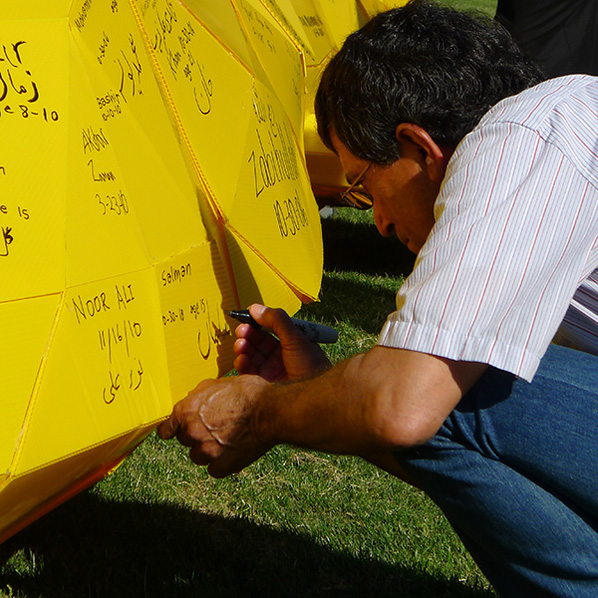
Joseph DeLappe’s website: http://www.delappe.net
A previous furtherfield interview on another drone-related project by DeLappe:
The 1,000 Drones Project, by Marc Garrett – 05/02/2014, furtherfield.org
http://furtherfield.org/features/interviews/1000-drones-project-interview-joseph-delappe
News story on US Military objections to ‘Medal of Honor’:
Sales of new ‘Medal of Honor’ video game banned on military bases, by Anne Flaherty – 09/09/2010, Washington Post
http://www.washingtonpost.com/wp-dyn/content/article/2010/09/08/AR2010090807219.html
News story and video on the Drone Memorial:
Drone project at Fresno State a call for ‘contemplation’ (video), by Carmen George – 03/26/2014, The Fresno Bee
http://www.fresnobee.com/2014/03/26/3845089/drone-project-at-fresno-state.html
Fresno College Newspaper story on the Drone Memorial:
Drone sculpture construction begins, by Collegian Staff – 03/18/2014, The Collegian at Fresno State
Drone sculpture construction begins
Essay on the visualization of the “Enemy” in military games, with a focus on “America’s Army”:
The Unreal Enemy of America’s Army, by Robertson Allen – 01/2011, Games and Culture 6(1):38–60
http://www.academia.edu/231295/The_Unreal_Enemy_of_Americas_Army